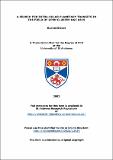Files in this item
A search for extra-solar planetary transits in the field of open cluster NGC 6819
Item metadata
| dc.contributor.advisor | Horne, Keith | |
| dc.contributor.author | Street, Rachel | |
| dc.coverage.spatial | xvi, 208 p. | en_US |
| dc.date.accessioned | 2018-03-14T13:46:02Z | |
| dc.date.available | 2018-03-14T13:46:02Z | |
| dc.date.issued | 2002 | |
| dc.identifier.uri | https://hdl.handle.net/10023/12939 | |
| dc.description.abstract | The technique of searching for extra-solar planetary transits is investigated. This technique, which relies on detecting the brief, shallow eclipses caused by planets passing across the line of sight to the primary star, requires high-precision time-series photometry of large numbers of stars in order to detect these statistically rare events. Observations of ~ 18000 stars in the field including the intermediate-age open cluster NGC 6819 are presented. This target field contrasts with the stellar environment surveyed by the radial velocity technique, which concentrates on the Solar neighbourhood. I present the data-reduction techniques used to obtain high-precision photometry in a semi-automated fashion for tens of thousands of stars at a time, together with an algorithm designed to search the resulting lightcurves for the transit signatures of hot Jupiter type planets. I describe simulations designed to test the detection efficiency of this algorithm and, for comparison, predict the number of transits expected from this data, assuming that hot Jupiter planets similar to HD 209458 are as common in the field of NGC 6819 as they are in the Solar neighbourhood. While no planetary transits have yet been identified, the detection of several very low amplitude eclipses by stellar companions demonstrates the effectiveness of the method. This study also indicates that stellar activity and particularly blending are significant causes of false detections. A useful additional consequence of studying this time-series photometry is the census it provides of some of the variable stars in the field. I report on the discovery of a variety of newly-discovered variables, including Algol-type detached eclipsing binaries which are likely to consist of M-dwarf stars. Further study of these stars is strongly recommended in order to help constrain models of stellar structure at the very low mass end. I conclude with a summary of this work in the context of other efforts being made in this field and recommend promising avenues of further study. | en_US |
| dc.language.iso | en | en_US |
| dc.publisher | University of St Andrews | |
| dc.subject.lcc | QB855.5S8 | |
| dc.subject.lcsh | Extrasolar planets. | en |
| dc.subject.lcsh | Transits. | en |
| dc.title | A search for extra-solar planetary transits in the field of open cluster NGC 6819 | en_US |
| dc.type | Thesis | en_US |
| dc.type.qualificationlevel | Doctoral | en_US |
| dc.type.qualificationname | PhD Doctor of Philosophy | en_US |
| dc.publisher.institution | The University of St Andrews | en_US |
This item appears in the following Collection(s)
Items in the St Andrews Research Repository are protected by copyright, with all rights reserved, unless otherwise indicated.

